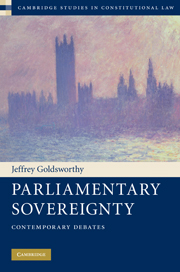Book contents
- Frontmatter
- Contents
- Detailed table of contents
- Acknowledgments
- 1 Introduction
- 2 The myth of the common law constitution
- 3 Legislative sovereignty and the rule of law
- 4 Homogenising constitutions
- 5 Abdicating and limiting Parliament's sovereignty
- 6 Trethowan's case
- 7 Requirements as to procedure or form for legislating
- 8 Judicial review, legislative override, and democracy
- 9 Parliamentary sovereignty and statutory interpretation
- 10 Challenging parliamentary sovereignty: Past, present and future
- Index
- References
4 - Homogenising constitutions
Published online by Cambridge University Press: 05 October 2010
- Frontmatter
- Contents
- Detailed table of contents
- Acknowledgments
- 1 Introduction
- 2 The myth of the common law constitution
- 3 Legislative sovereignty and the rule of law
- 4 Homogenising constitutions
- 5 Abdicating and limiting Parliament's sovereignty
- 6 Trethowan's case
- 7 Requirements as to procedure or form for legislating
- 8 Judicial review, legislative override, and democracy
- 9 Parliamentary sovereignty and statutory interpretation
- 10 Challenging parliamentary sovereignty: Past, present and future
- Index
- References
Summary
Introduction
From the late eighteenth century until recently, the common law world included just two alternative constitutional models for the protection of individual rights. The first, developed in Britain, is the model of parliamentary sovereignty, which reposes primary responsibility for protecting rights in parliaments. The second, developed in the United States, is the model of judicial review, which reposes that responsibility in courts of law. In countries founded by Britain, the first model was established; even when federations were formed, in Australia and Canada, judicial review was adopted only as a means of policing the federal distribution of powers, and not (generally speaking) as a means of protecting rights. Some former British dominions adopted the American model upon or after achieving independence, such as Ireland, India and (more recently) South Africa. But otherwise, the British model predominated throughout the common law world.
Recently, Canada, New Zealand and Britain have adopted ‘hybrid’ models, which allocate much greater responsibility for protecting rights to courts, without altogether abandoning the principle of parliamentary sovereignty. In Canada, judicial enforcement of the Charter of Rights 1982 is for the most part subject to s. 33, which permits legislatures by express provision to override most of the rights protected by the Charter. To that extent, the principle of parliamentary sovereignty has been retained, although in practice the power of override is seldom used.
- Type
- Chapter
- Information
- Parliamentary SovereigntyContemporary Debates, pp. 79 - 105Publisher: Cambridge University PressPrint publication year: 2010

